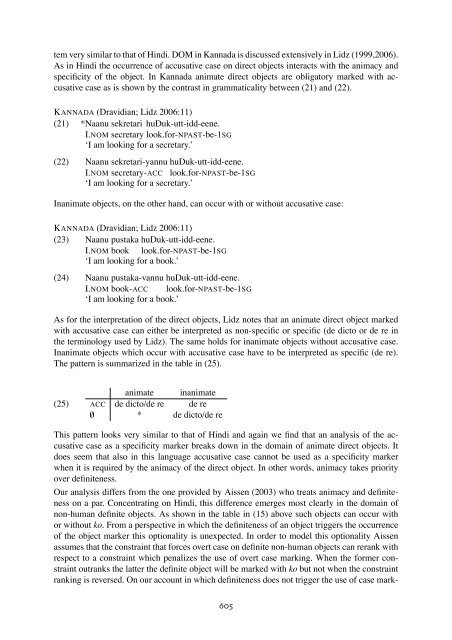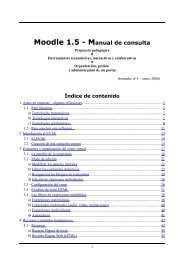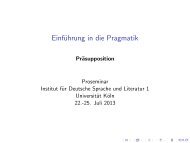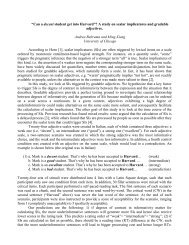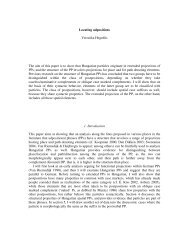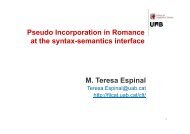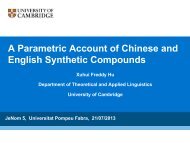Semantic aspects of differential object marking - corpora@parles.upf ...
Semantic aspects of differential object marking - corpora@parles.upf ...
Semantic aspects of differential object marking - corpora@parles.upf ...
Create successful ePaper yourself
Turn your PDF publications into a flip-book with our unique Google optimized e-Paper software.
8 Peter de Swart and Helen de Hoop<br />
tem very similar to that <strong>of</strong> Hindi. DOM in Kannada is discussed extensively in Lidz (1999,2006).<br />
As in Hindi the occurrence <strong>of</strong> accusative case on direct <strong>object</strong>s interacts with the animacy and<br />
specificity <strong>of</strong> the <strong>object</strong>. In Kannada animate direct <strong>object</strong>s are obligatory marked with accusative<br />
case as is shown by the contrast in grammaticality between (21) and (22).<br />
KANNADA (Dravidian; Lidz 2006:11)<br />
(21) *Naanu sekretari huDuk-utt-idd-eene.<br />
I.NOM secretary look.for-NPAST-be-1SG<br />
‘I am looking for a secretary.’<br />
(22) Naanu sekretari-yannu huDuk-utt-idd-eene.<br />
I.NOM secretary-ACC look.for-NPAST-be-1SG<br />
‘I am looking for a secretary.’<br />
Inanimate <strong>object</strong>s, on the other hand, can occur with or without accusative case:<br />
KANNADA (Dravidian; Lidz 2006:11)<br />
(23) Naanu pustaka huDuk-utt-idd-eene.<br />
I.NOM book look.for-NPAST-be-1SG<br />
‘I am looking for a book.’<br />
(24) Naanu pustaka-vannu huDuk-utt-idd-eene.<br />
I.NOM book-ACC look.for-NPAST-be-1SG<br />
‘I am looking for a book.’<br />
As for the interpretation <strong>of</strong> the direct <strong>object</strong>s, Lidz notes that an animate direct <strong>object</strong> marked<br />
with accusative case can either be interpreted as non-specific or specific (de dicto or de re in<br />
the terminology used by Lidz). The same holds for inanimate <strong>object</strong>s without accusative case.<br />
Inanimate <strong>object</strong>s which occur with accusative case have to be interpreted as specific (de re).<br />
The pattern is summarized in the table in (25).<br />
(25)<br />
animate inanimate<br />
ACC de dicto/de re de re<br />
/0 * de dicto/de re<br />
This pattern looks very similar to that <strong>of</strong> Hindi and again we find that an analysis <strong>of</strong> the accusative<br />
case as a specificity marker breaks down in the domain <strong>of</strong> animate direct <strong>object</strong>s. It<br />
does seem that also in this language accusative case cannot be used as a specificity marker<br />
when it is required by the animacy <strong>of</strong> the direct <strong>object</strong>. In other words, animacy takes priority<br />
over definiteness.<br />
Our analysis differs from the one provided by Aissen (2003) who treats animacy and definiteness<br />
on a par. Concentrating on Hindi, this difference emerges most clearly in the domain <strong>of</strong><br />
non-human definite <strong>object</strong>s. As shown in the table in (15) above such <strong>object</strong>s can occur with<br />
or without ko. From a perspective in which the definiteness <strong>of</strong> an <strong>object</strong> triggers the occurrence<br />
<strong>of</strong> the <strong>object</strong> marker this optionality is unexpected. In order to model this optionality Aissen<br />
assumes that the constraint that forces overt case on definite non-human <strong>object</strong>s can rerank with<br />
respect to a constraint which penalizes the use <strong>of</strong> overt case <strong>marking</strong>. When the former constraint<br />
outranks the latter the definite <strong>object</strong> will be marked with ko but not when the constraint<br />
ranking is reversed. On our account in which definiteness does not trigger the use <strong>of</strong> case mark-<br />
605<br />
8


